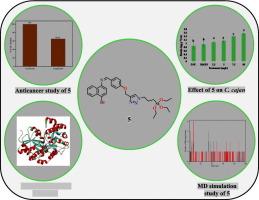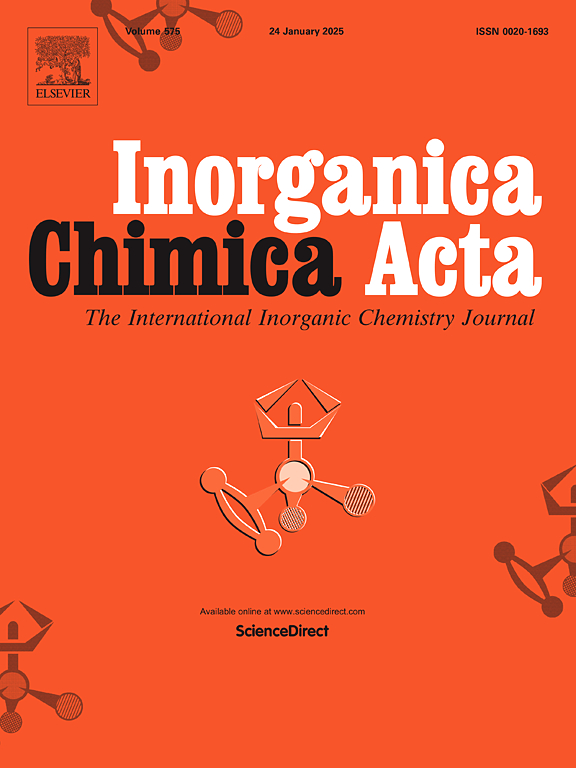通过体内、分子对接和MD模拟等方法,揭示了click合成1,2,3-三唑作为抗癌药物的潜力,以及其作为植物生长调节剂的潜力
IF 3.2
3区 化学
Q2 CHEMISTRY, INORGANIC & NUCLEAR
引用次数: 0
摘要
在浸润性宫颈癌的标准治疗中,通常采用根治性手术或放射治疗。作为这些治疗的结果,生育的可能性被消除。尽管如此,一种保留生育能力的替代方法,如根治性气管切除术,已被证明是成功的,只要遵守严格的选择标准。更传统的方法,高生育率和低复发率来处理宫颈肿瘤是必要的。本研究利用点击化学方法合成了新的1,2,3-三唑5(a-c),并利用核磁共振(1H和13C)、傅里叶变换红外(FT-IR)和质谱技术对其结构进行了表征。化合物5a对宫颈癌的疗效进行了测试,发现与未经处理的对照细胞相比,细胞存活率显著降低至65.13%。此外,研究了化合物5a对Cajanus cajan (C. cajan)萌发、生长和生理反应的影响,发现其在浓度为10 mg/L时效果最佳。利用分子对接解释了hpv16抗癌蛋白与化合物5a可能的结合,结果显示结合能为- 7.68 kcal/mol。通过分子动力学模拟进一步评估化合物5a与HPV 16相互作用的稳定性。化合物5a的研究结果表明其作为抗癌药物和植物生长调节剂的应用前景广阔。本文章由计算机程序翻译,如有差异,请以英文原文为准。

Unveiling the potential of click synthesized 1,2,3-triazole as an anticancer agent via in vivo, molecular docking and MD simulation approaches and its aptitude as plant growth regulator on Cajanus cajan
In the standard management of invasive cervical cancer, radical surgery or radiotherapy are typically employed. As a consequence of these treatments, the possibility of childbearing is eliminated. Nonetheless, a fertility-preserving alternative, such as radical trachelectomy, has proven to be successful, given adherence to stringent selection criteria. A more conventional approach with high fertility rates and low recurrence rates to deal with cervical tumor is necessary. In this research, new 1,2,3-triazoles 5(a-c) were synthesized utilizing click chemistry approach and their structures were well characterized using NMR (1H and 13C), FT-IR and mass spectrometry techniques. The efficacy of compound 5a against cervical cancer was tested, revealing a significant reduction in cell viability to 65.13 % compared to untreated control cells. Additionally, the impact of compound 5a on the germination, growth, and physiological responses of Cajanus cajan (C. cajan) was investigated, highlighting its optimal effects at a concentration of 10 mg/L. The possible attachment of the HPV 16 anti-cancer protein to compound 5a was explained using molecular docking, revealing notable outcomes with an excellent binding energy of −7.68 kcal/mol. The stability of the interaction between compound 5a and HPV 16 was further assessed through molecular dynamics simulation. The results obtained from the compound 5a's studies suggest its potential as a promising anticancer agent and a possible plant growth regulator in future applications.
求助全文
通过发布文献求助,成功后即可免费获取论文全文。
去求助
来源期刊

Inorganica Chimica Acta
化学-无机化学与核化学
CiteScore
6.00
自引率
3.60%
发文量
440
审稿时长
35 days
期刊介绍:
Inorganica Chimica Acta is an established international forum for all aspects of advanced Inorganic Chemistry. Original papers of high scientific level and interest are published in the form of Articles and Reviews.
Topics covered include:
• chemistry of the main group elements and the d- and f-block metals, including the synthesis, characterization and reactivity of coordination, organometallic, biomimetic, supramolecular coordination compounds, including associated computational studies;
• synthesis, physico-chemical properties, applications of molecule-based nano-scaled clusters and nanomaterials designed using the principles of coordination chemistry, as well as coordination polymers (CPs), metal-organic frameworks (MOFs), metal-organic polyhedra (MPOs);
• reaction mechanisms and physico-chemical investigations computational studies of metalloenzymes and their models;
• applications of inorganic compounds, metallodrugs and molecule-based materials.
Papers composed primarily of structural reports will typically not be considered for publication.
 求助内容:
求助内容: 应助结果提醒方式:
应助结果提醒方式:


